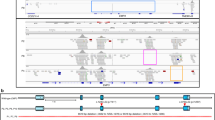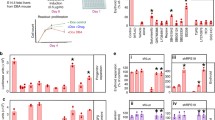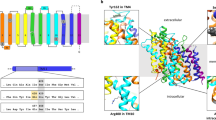Abstract
Thiamine-responsive megaloblastic anaemia syndrome (TRMA; MIM 249270) is an autosomal recessive disorder with features that include megaloblastic anaemia, mild thrombocytopenia and leucopenia, sensorineural deafness and diabetes mellitus1,2,3. Treatment with pharmacologic doses of thiamine ameliorates the megaloblastic anaemia and diabetes mellitus. A defect in the plasma membrane transport of thiamine has been demonstrated in erythrocytes and cultured skin fibroblasts from TRMA patients4,5,6. The gene causing TRMA was assigned to 1q23.2–q23.3 by linkage analysis7. Here we report the cloning of a new gene, SLC19A2, identified from high-throughput genomic sequences due to homology with SLC19A1, encoding reduced folate carrier 1 (refs 8,9,10).We cloned the entire coding region by screening a human fetal brain cDNA library. SLC19A2 encodes a protein (of 497 aa) predicted to have 12 transmembrane domains. We identified 2 frameshift mutations in exon 2, a 1-bp insertion and a 2-bp deletion, among four Iranian families with TRMA. The sequence homology and predicted structure of SLC19A2, as well as its role in TRMA, suggest that its gene product is a thiamine carrier, the first to be identified in complex eukaryotes.
This is a preview of subscription content, access via your institution
Access options
Subscribe to this journal
Receive 12 print issues and online access
$209.00 per year
only $17.42 per issue
Buy this article
- Purchase on Springer Link
- Instant access to full article PDF
Prices may be subject to local taxes which are calculated during checkout




Similar content being viewed by others
References
Rogers, L.E., Porter, F.S. & Sidbury, J.B.J. Thiamine-responsive megaloblastic anemia. J. Pediatr. 74, 494–504 (1969).
Viana, M.B. & Carvalho, R.I. Thiamine-responsive megaloblastic anemia, sensorineural deafness, and diabetes mellitus: a new syndrome? J. Pediatr. 93, 235–238 (1978).
Mandel, H., Berant, M., Hazani, A. & Naveh, Y. Thiamine-dependent beriberi in the "thiamine-responsive anemia syndrome". N. Engl. J. Med. 311, 836–838 ( 1984).
Rindi, G. et al. Further studies on erythrocyte thiamin transport and phosphorylation in seven patients with thiamin-responsive megaloblastic anaemia. J. Inherit. Metab. Dis. 17, 667–677 (1994).
Rindi, G. et al. Thiamine transport in erythrocytes and ghosts in thiamine-responsive megaloblastic anaemia. J. Inherit. Metab. Dis. 15, 231–242 (1992).
Stagg, A.R. et al. Defective high-affinity thiamine transporter leads to cell death in thiamine-responsive megaloblastic anemia syndrome fibroblasts. J. Clin. Invest. 103, 723–729 (1999).
Neufeld, E.J. et al. Localization of the gene for thiamine-responsive megaloblastic anemia syndrome, on the long arm of chromosome 1, by homozygosity mapping. Am. J. Hum. Genet. 61, 1335– 1341 (1997).
Prasad, P.D., Ramamoorthy, S., Leibach, F.H. & Ganapathy, V. Molecular cloning of the human placental folate transporter. Biochem. Biophys. Res. Commun. 206, 681–687 (1995).
Williams, F.M.R. & Flintoff, W.F. Isolation of a human cDNA that complements a mutant hamster cell defective in methotrexate uptake. J. Biol. Chem. 270, 2987– 2992 (1995).
Wong, S.C., Proefke, S.A., Bhushan, A. & Matherly, L.H. Isolation of human cDNAs that restore methotrexate sensitivity and reduced folate carrier activity in methotrexate transport-defective Chinese hamster ovary cells. J. Biol. Chem. 270, 17468– 17475 (1995).
Banikazemi, M. et al. Localization of the thiamine-responsive megaloblastic anemia syndrome locus to a 1.5-cM region of 1q23. Mol. Genet. Metab. 66, 193–198 (1999).
Singleton, C.K. Identification and characterization of the thiamine transporter gene of Saccharomyces cerevisae. Gene 199, 111 –121 (1997).
Enjo, F., Nosaka, K., Ogata, M., Iwashima, A. & Nishimura, H. Isolation and characterization of a thiamin transport gene, THI10, from Saccharyomyces cerevisiae. J. Biol. Chem. 272, 19165–19170 ( 1997).
Kozak, M. Point mutations define a sequence flanking the AUG initiator codon that modulates translation by eukaryotic ribosomes. Cell 44, 283–292 (1986).
Kozak, M. An analysis of 5´-noncoding sequences from 699 vertebrate messenger RNAs. Nucleic Acids Res. 15, 8125– 8148 (1987).
Wilson, J.D. >Vitamin deficiency and excess. in Harrison's Principles of Internal Medicine (eds Fauci, A.S. et al.) 480–489 (McGraw-Hill, New York, 1998).
Laforenza, U., Orsenigo, M.N. & Rindi, G. A thiamine/H+ antiport mechanism for thiamine entry into brush border membrane vesicles from rat small intestine. J. Membr. Biol. 161, 151– 161 (1998).
Benson, G. Tandem repeats finder: a program to analyze DNA sequences. Nucleic Acids Res. 2, 573–580 ( 1999).
Tusnady, G.E. & Simon, I. Principles governing amino acid composition of integral membrane proteins: applications to topology prediction. J. Mol. Biol. 283, 489–506 (1998).
Acknowledgements
We thank the TRMA kindreds for participation; P. Vossough and M. Jalali for referring the TRMA families; V. Busygina and C. Peredo for DNA sequencing; and D. Bishop for insights. This study was supported in part by NIH grants to the Mount Sinai Child Health Research (5 P30 HD 28822) and the General Clinical Research (P01-HD28822) Centers.
Author information
Authors and Affiliations
Corresponding author
Rights and permissions
About this article
Cite this article
Diaz, G., Banikazemi, M., Oishi, K. et al. Mutations in a new gene encoding a thiamine transporter cause thiamine-responsive megaloblastic anaemia syndrome. Nat Genet 22, 309–312 (1999). https://doi.org/10.1038/10385
Received:
Accepted:
Issue Date:
DOI: https://doi.org/10.1038/10385
This article is cited by
-
Pharmacogenomics in diabetes: outcomes of thiamine therapy in TRMA syndrome
Diabetologia (2018)
-
Not quite type 1 or type 2, what now? Review of monogenic, mitochondrial, and syndromic diabetes
Reviews in Endocrine and Metabolic Disorders (2018)
-
Involvement of Organic Cation Transporters in the Clearance and Milk Secretion of Thiamine in Mice
Pharmaceutical Research (2015)
-
The physiological role of drug transporters
Protein & Cell (2015)
-
Thiamine-responsive megaloblastic anemia syndrome with Ebstein anomaly: a case report
European Journal of Pediatrics (2014)



